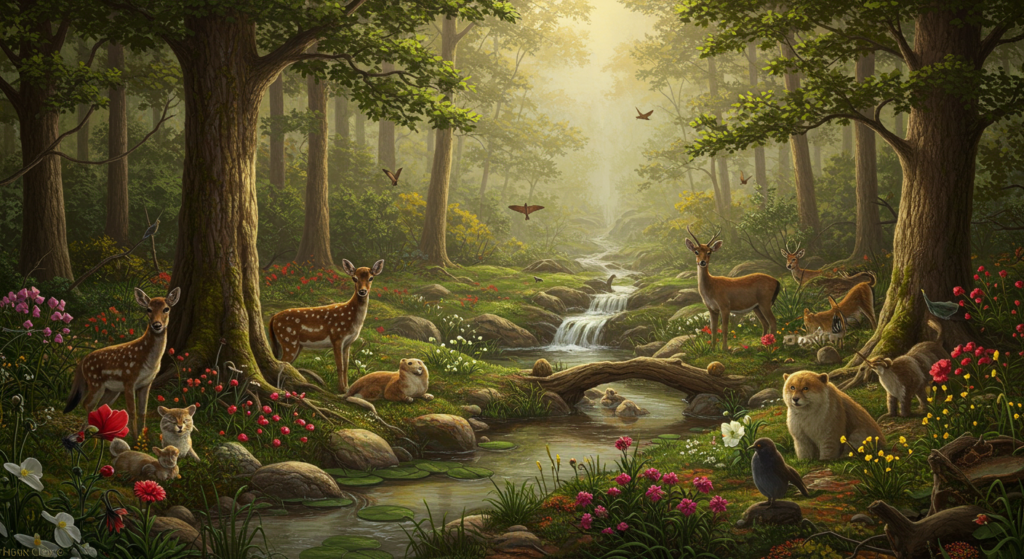
This is part 2 of this topic.
In this post, we will look at a few of the key “parallel” realities expressed in Genesis chapters 1 and 2, introduced in part 1 of this post. In summary, the items spoken of in these two chapters express both a physical and a spiritual reality. The physical reality is what is essentially the literal expression of the words used by Moses, the presumed author of Genesis. Some of the items pertain to the process of creation itself (such as the fourth day lights), while others point to items after creation had been complete.
Light
In Gen 1:3, God commanded light to be, and it was. This is certainly referring to the physical reality of light as an element of creation, such as sunlight and light emitted by other celestial bodies. Scriptures reveal that light is one of God’s characteristics, inseparable from His person. Psa 104:2 speaks of God as one “wrapped with light as with a garment”. In the New Testament, there are many references to light, primarily attributed to Christ as the “true light” (John 1:9, 9:5), but also to His believers as light (Matt 5:14). Ultimately, in the holy city, New Jerusalem, God radiates Himself as light through His elect, like a prism (Rev 21:11). By these we can clearly see that while light in Gen 1 was a definite physical reality, it is also an allusion to a spiritual reality of God as light in various aspects.
Lights
Gen 1:14-16 speak of a word commonly translated as “lights”, which is different from the light in 1:3. In Hebrew, this word refers to “luminaries” or luminous bodies of light, a clear allusion to heavenly bodies such as the sun, moon, and the stars. Once again, we see evident physical reality based on a literal reading. But consider its spiritual parallel. Who or what are the “luminaries” in a spiritual sense? There are quite a few references in the New Testament concerning God’s children as light, such as in Matt 5:14. In the Septuagint or LXX (Greek translation of the Old Testament), the word used in Gen 1:14 is “φωστῆρες”, which means “luminaries”, which is the exact same word used by Apostle Paul in Phil 2:15, where he refers to the Philippian believers as “lights” or luminaries, to underscore their status as those who emanate spiritual light in a dark world. We may surmise that luminaries in a spiritual sense are God’s people who shine Him forth as light in a dark world.
Garden of Eden (“Paradise”)
The garden of Eden was a special place that God Himself “planted” and designated for Adam and Eve to be their domicile (Gen 2: 8, 15). Eden was a delightful paradise, a pinnacle of God’s creation full of fruit-yielding trees and meandering rivers that watered it with rich minerals (2:9-14). That was the physical reality – the garden was just as real and corporeal as the Adam and Eve were. The garden also points to a spiritual reality. In the heavenly abode of God, there is a heavenly paradise, a spiritual equivalent of the garden of Eden. In Luke 23:43, Jesus assured one of the robbers on the cross that he will be with Him “in Paradise”. In Rev 2:7, Jesus promises overcomers that they will partake of the tree of life in the “Paradise of God”. We may say that Eden was a prefigure, an earthly miniature of the true Paradise in the heavens. The earthly garden of Eden was likely destroyed by the flood (Gen 7) some sixteen centuries after Adam’s creation, but the garden of God or “Paradise” is the spiritual reality that will exist eternally within the walls of the holy city, New Jerusalem (Rev 21:2,10-12).
The two trees
In the garden we see a multiplicity of trees, with special attention given to two trees – the tree of life and the tree of knowledge of good and evil. These two were centered in the “middle of the garden” (2:9)
Tree of life
The tree of life is portrayed as one of the multitude of trees that were good for food, but its placement in the middle of the garden indicates its primacy and superiority over all the other trees (2:9). Furthermore, it possessed the nature of immortality. We may not be too concerned with how it came to possess immortality – whether through God’s speaking or by a miraculous impartation of God’s breath; it’s sufficient to know that it possessed the character and nature of immortality. But after Adam sinned, access to the tree of life was cutoff as seen in 3:22 and 3:24. What is just as relevant to the Christian reader is its spiritual reality. As we saw above, in the Scriptures God Himself is depicted as the tree of life, which access Christ secured for mankind. Furthermore, Christ promises the overcomers the reward of partaking of its fruits (Rev 2:7).
Tree of knowledge of good and evil
It is noteworthy that God specifically warns Adam about partaking of the tree of knowledge of good and evil, lest he die (2:17), but no specific instruction was given concerning the tree of life. This tree, although created in perfection, was stricken with sin with its effect of mortality (death). Here one can observe the polar opposite effect of consuming from the tree of life. While the tree of life bestowed immortality to its partakers, the tree of knowledge of good and evil imparted mortality to its partakers. One might wonder what is the spiritual reality of this tree. The effect of consuming of this tree was death (mortality), just as God warned about. In Rom 5:12, Apostle Paul says “through one man sin entered into the world, and through sin death”, and again confirming these principles in 1 Cor 15:21-22. This clearly corroborates what God spoke of in 2:17. The effect of death was both physical and spiritual – the man who was intended to become immortal became mortal, while also rendering him incapable of knowing God, with his spirit becoming deadened (Eph 2:5). From this we can conclude that the tree of knowledge of good and evil is a figure of Satan, with his sinful nature and its effect of death, just as the tree of life was a figure of God as eternal life.
(We will have a more in-depth look at the garden and the two trees in a future post)
River
A river is mentioned in 2:10 and its tributaries which implies the main river must have been large enough to supply a tributary as wide as the Euphrates. The primary purpose of the river was to water the garden and cause its trees and vegetation to flourish as well as to be a water supply for Adam and Eve. A secondary purpose was to deposit rich minerals such as gold and bdellium into the soil to create an abundance of natural wealth in and around the garden. All of these are undeniable physical realities while pointing to a spiritual one vividly portrayed in Revelation 22:1. There it describes the “river of water of life” that waters the entire holy city of New Jerusalem.
Man (Adam)
In Gen 2:26 God made an intentional decision to make man in His own image and according to His likeness. This man, later referred to as Adam in 2:20 is the forefather of all of humanity, labelled as the “first man” in 1 Cor 15:45. The Scriptures unequivocally points to Christ as the true spiritual equivalent of Adam, and given the title of “last Adam” (1 Cor 15:45).
Woman (Eve)
The woman whom Adam named “Eve” in 3:20 was created as a counterpart to Adam in a unique way. She was built out of the rib of Adam in 2:22 and brought to him as his counterpart. The spiritual reality of the woman is the church, who will be brought to Christ as His bride (Eph 5:27, Rev 21:2)
Man and Woman as a couple
God ordained that man and woman be joined and become “one flesh” (2:23). This also points to a spiritual reality of Christ and His elect becoming one as a spiritual couple, implying a spiritual marriage where the two shall become one. This is a great mystery as Apostle Paul indicated in Eph 5:31-32, but one that will be fulfilled in the future (Rev 19:7) and become evident to all in eternity
Serpent
Finally, we have the portrayal of the serpent. The serpent typically conjures up the image of a creeping, slithering reptile. However, it is very likely that the before the curse, the serpent was a majestic creature that looked superior to the other beasts. In fact, the serpent could “talk” or somehow communicate with the woman (3:1, 14). The serpent was like any other animal, but was more wily (3:1). God permitted Satan to subdue and wholly possess the serpent. Ultimately the serpent became Satan’s instrument to deceive and tempt the woman to disobey God’s commandment. Moreover, we can also assume that the serpent was allowed to enter the garden of Eden and occupy a preeminent position in it. One could imagine the encounter between the woman and the serpent in 3:1-6 with Eve strolling through the garden and the serpent walking alongside her conducting his discourse. Or perhaps he may have been perched up as a winged beast on the tree of knowledge of good and evil while Eve was gazing at the tree. What should one make of the spiritual reality behind the serpent? There are many instances of serpent cast in a negative light throughout the Scriptures. One of the more significant ones is found in John 3:14 where Jesus likens Himself to the serpent that Moses lifted up in the wilderness. This is indicative of the fact that Jesus Himself became the “serpent” in likeness so God could judge Him for the sins of humanity. Then in Revelation the serpent is equated with the great red dragon which is called “the ancient serpent”. Very significantly, the serpent himself is identified as one and the same as the devil (Rev 20:2), who will ultimately be cast into the lake of fire (Rev 20:10)
Conclusion
As we have seen, the book of Genesis is not just a mere rendering of the account of creation. It contains many physical truths that should be interpreted in a literal sense, but each of these pointing to definite spiritual realities throughout the Bible. These spiritual realities are being developed throughout the course of human history ultimately consummating in the new heaven and the new earth. The Christian reader should avoid the tendency to fully allegorize the matters presented in the account of creation at the expense of a literal reading, while recognizing the spiritual parallels found in Genesis 1-2. These two parallel realities should guide our interpretation, understanding and anchor us to the true meaning of these divinely inspired words.
